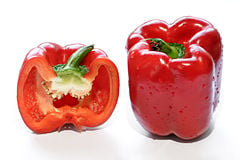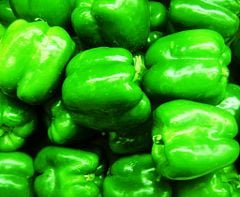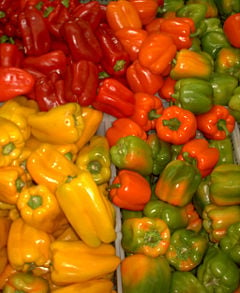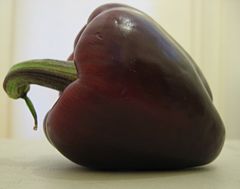Bell pepper
| Bell pepper | ||||||||||||||||
|---|---|---|---|---|---|---|---|---|---|---|---|---|---|---|---|---|
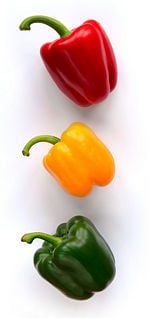 Red, yellow and green pepper
| ||||||||||||||||
| Scientific classification | ||||||||||||||||
| ||||||||||||||||
| Capsicum annuum L. |
| Heat: None (SR: 0) |
Bell pepper is the common name for a cultivar group of the species Capsicum annuum, widely cultivated for their edible, bell-shaped fruits, which are characterized by a glossy exterior of different colors, including red, yellow, green, and orange. Bell peppers are sometimes grouped with less pungent pepper varieties of Capsicum annuum known as "sweet peppers." There also are varieties of C. annuum that are pungent or hot, such as the cayenne and jalapeño peppers. Bell peppers contain a recessive gene that eliminates capsaisin, the alkaloid that causes "hotness" in other plants in the genus Capsicum.
With their beautifully shaped form and vividly colored exterior of diverse colors, bell peppers have been called "the Christmas ornaments of the vegetable world," to which is added a crunchy texture and tangy taste (GMF 2008). Building on the diversity in nature, bell peppers reflect the remarkable creativity of human beings, both in the development of numerous cultivars and in the diverse dishes in which they are used.
Overview and description
Family Solanaceae and genus Capsicum
Bell peppers belong to the Solanaceae, the potato or nightshade family, a group of flowering plants in the Solanales order. Solanaceae includes some of the more important food and drug-producing plants, including potato, tomato, eggplant, tobacco, chili pepper, and deadly nightshade. Members of Solanaceae are characterized by five-petaled flowers, typically conical or funnelform, and alternate or alternate to opposite leaves.
The genus to which bell peppers belong is Capsicum. Capsicum contains approximately 20-27 species (Walsh and Hoot 2001), five of which are domesticated: C. annuum, C. baccatum, C. chinense, C. frutescens, and C. pubescens (Heiser and Pickersgill 1969). (Other taxonomic schemes may exhibit far less variety in species. See ITIS 1999a). Fruits of Capsicum can vary tremendously in color, shape, and size both between and within species, which has led to confusion over the relationships between taxa (Eshbaugh 1975). Chemosystematic studies help distinguish differences between varieties and species. For example, C. baccatum var. baccatum had the same flavonoids as C. baccatum var. pendulum, which led researchers to believe that the two groups belonged to the same species (Ballard et al. 1970).
The fruit of Capsicum plants have a variety of names depending on place and type. Common names include chili pepper, capsicum, red or green pepper, or sweet pepper in Britain, and typically just capsicum in Australia and Indian English. The large mild form is called bell pepper in the US. They are called paprika in some other countries (although paprika can also refer to the powdered spice made from various capsicum fruit).
The fruit of most species of Capsicum contains capsaicin (methyl vanillyl nonenamide), a lipophilic chemical that can produce a strong burning sensation in the mouth (and, if not properly digested, the anus) of the unaccustomed eater. Capsicum stimulates chemoreceptor nerve endings in the skin, especially the mucous membranes. Most mammals find this unpleasant; however, birds appear unaffected (Mason et al. 1991; Norman et al. 1992). The secretion of capsaicin is an adaptation to protect the fruit from consumption by mammals, while the bright colors attract birds that will spread the seeds.
The amount of capsaicin in Capsicum species and varieties is highly variable and dependent on genetics, giving almost all types of capsicums varied amounts of perceived heat. Chili peppers are of great importance in Native American medicine, and capsaicin is used in modern Western medicine—mainly in topical medications—as a circulatory stimulant and pain reliever. Although black pepper and Sichuan pepper cause similar burning sensations, they are caused by different substances—piperine and alpha-hydroxy-sanshool, respectively.
Bell peppers
Bell pepper is a cultivar group of the species Capsicum annuum. Cultivar is a horticultural term for a group of cultivated plants that have been selected and given a unique name because of desirable characteristics (decorative or useful) that distinguish this assemblage from otherwise similar plants of the same species. When propagated, sexually or asexually, the plants retain those characteristics. A cultivar group is any gathering of cultivars designated by common traits.
Bell peppers have a glossy exterior of different, vivid colors, including red, yellow, orange, green, purple, brown, and black (GMF 2008). They tend to be plump, bell-shaped vegetables with three or four lobes (GMF 2008).
Bell peppers are unique in that, unlike other members of Capsicum, they do not produce appreciable capsaicin. The production of this chemical substance depends on a single gene, with bell pepper varieties having in recessive form (PFAF 2008; GMF 2008). This results in a zero rating on the Scoville scale, a rating designed to measure of the hotness or, more correctly, piquancy of a chili pepper.
Bell pepper is just one of many varieties of C. annuum. This same species has other varieties as well, such as the Anaheim chiles often used for stuffing, the dried Ancho chile used to make chili powder, the mild-to-hot jalapeño, and the smoked, ripe Jalapeño, known as a Chipotle.
Varieties of bell peppers
The color of bell peppers can be green, red, yellow, orange, and, more rarely, white, purple, blue, brown, and black, depending on when they are harvested and the specific cultivar. Green peppers are unripe bell peppers, while the others are all ripe, with the color variation based on cultivar selection.
Because they are unripe, green peppers are less sweet and slightly more bitter than yellow, orange, purple, or red peppers. Purple cultivars also tend to be slightly bitter, while red, orange, and yellow are sweeter and almost fruity (GMF 2008).
The taste of ripe peppers can also vary with growing conditions and post-harvest storage treatment; the sweetest are fruit allowed to ripen fully on the plant in full sunshine, while fruit harvested green and after-ripened in storage are less sweet.
History and nomenclature
Peppers are native to Central and South America. Pepper seeds were later carried to Spain in 1493 and from there spread to other European and Asian countries.
The term "bell pepper" is one of the many names for some fruits of the Capsicum annuum species of plants. The misleading name "pepper" (pimiento in Spanish) was given by Christopher Columbus upon bringing the plant back to Europe. At that time peppercorns (black pepper, Piper nigrum) were a highly prized condiment.
Today, the term "bell pepper" or "pepper" or "capsicum" is often used for any of the large bell shaped capsicum fruits, regardless of their color. In British English, the fruit is simply referred to as a "pepper," whereas in many Commonwealth of Nations countries, such as Australia, India, Malaysia, and New Zealand, they are called "capsicum." Across Europe, the term "paprika," which has its roots in the word for pepper, is used—sometimes referred to by their color (e.g. "groene paprika," "gele paprika," in Dutch, which are green and yellow, respectively). Paprika also refers to the powdered spice made from the same fruit. In France, it is called "poivron" or "piment." In Japan, the word ピーマン ("pîman," from the French) refers only to green bell peppers, whereas パプリカ ("papurika," from paprika) refers to bell peppers of other colors. In the United States and Canada, the fruit is often referred to simply as a "pepper" or referred to by color (e.g. "red pepper," "green pepper"), although the more specific term "bell pepper" is understood in most regions.
In parts of the United States around southern Ohio, Northeastern Pennsylvania, and northern Kentucky the term "mangoes" (or "mangos") has sometimes been used to refer to bell peppers. However, as the actual mango fruit has become more common in the region, this usage has faded.
In Russia, it is commonly called болгарский перец (bolgarskiy perets), meaning Bulgarian pepper. In France, it is called poivron, with the same root as poivre (meaning black pepper). In Denmark, the bell pepper is referred to as "peberfrugt," meaning pepper-fruit.
In Brazil, it is commonly called Pimentão, meaning big pepper. It is widely used in a variety of dishes, like pasta, rice and other dishes from Cuisine of Brazil.
Usess and nutrition
| Pepper, sweet, green raw Nutritional value per 100 g | ||||||||||||||||||||||||||||||||||
|---|---|---|---|---|---|---|---|---|---|---|---|---|---|---|---|---|---|---|---|---|---|---|---|---|---|---|---|---|---|---|---|---|---|---|
| Energy 20 kcal 80 kJ | ||||||||||||||||||||||||||||||||||
| ||||||||||||||||||||||||||||||||||
| Percentages are relative to US recommendations for adults. Source: USDA Nutrient database | ||||||||||||||||||||||||||||||||||
Bell peppers are sold in both its immature green state and its red, yellow, or orange ripe state. They may be eaten cooked or raw, such as in salads. They also may be ground in to a powder and added to fruit as a coloring or flavoring.
Bell peppers offer a number of nutritional values. They are excellent sources of vitamin C and vitamin A (GMF 2008). They also are a source of vitamin B6, folic acid, beta-carotene, and fiber. Red peppers also contain lycopene, believed important for reducing risk of certain cancers (prostate cancer, cancer of the cervix, bladder, and pancreas) (GMF 2008). Various studies on red peppers or their components support the view that bell peppers have a protective effect against cataracts, rheumatoid arthritis, and lung cancer (GMF 2008).
ReferencesISBN links support NWE through referral fees
- Ballard, R. E., J. W. McClure, W. H. Eshbaugh, and K. G. Wilson. 1970. A chemosystematic study of selected taxa of Capsicum American Journal of Botany 57(2): 225-233.
- Eshbaugh, W. H. 1975. Genetic and biochemical systematic studies of chili peppers (Capsicum-Solanaceae) Bulletin of the Torrey Botanical Club 102(6): 396-403.
- George Mateljan Foundation (GMF). 2008. Bell peppers World's Healthiest Foods. Retieved June 3, 2008.
- Germplasm Resources Information Network (GRIN). 2008a. Capsicum annuum L. var. annuum USDA, ARS, National Genetic Resources Program. Germplasm Resources Information Network. Retrieved June 3, 2008.
- Heiser, C. B., and B. Pickersgill. 1969. Names for the cultivated Capsicum species (Solanaceae) Taxon 18(3): 277-283.
- Integrated Taxonomic Information System (ITIS). 1999a. Solanaceae ITIS Taxonomic Serial No.: 30411. Retrieved May 25, 2008.
- Integrated Taxonomic Information System (ITIS). 1999b. Capsicum L. ITIS Taxonomic Serial No.: 30491. Retrieved May 25, 2008.
- Mason, J. R., N. J. Bean, P. S. Shah, and L. Clark. 1991. Taxon-specific differences in responsiveness to capsaicin and several analogues: Correlates between chemical structure and behavioral aversiveness. Journal of Chemical Ecology 17: 2539–2551.
- Norman, D. M., J. R. Mason, and L. Clark. 1992. Capsaicin effects on consumption of food by cedar waxwings and house finches. The Wilson Journal of Ornithology 104: 549–551.
- Plants For a Future (PFAF). 2008. Capsicum annuum Plants For A Future. Retrieved June 3, 2008.
- Walsh, B. M., and S. B. Hoot. 2001. Phylogenetic relationships of Capsicum (Solanaceae) using DNA sequences from two noncoding regions: The chloroplast atpB-rbcL spacer region and nuclear waxy introns. International Journal of Plant Sciences 162(6): 1409-1418.
Credits
New World Encyclopedia writers and editors rewrote and completed the Wikipedia article in accordance with New World Encyclopedia standards. This article abides by terms of the Creative Commons CC-by-sa 3.0 License (CC-by-sa), which may be used and disseminated with proper attribution. Credit is due under the terms of this license that can reference both the New World Encyclopedia contributors and the selfless volunteer contributors of the Wikimedia Foundation. To cite this article click here for a list of acceptable citing formats.The history of earlier contributions by wikipedians is accessible to researchers here:
The history of this article since it was imported to New World Encyclopedia:
Note: Some restrictions may apply to use of individual images which are separately licensed.
